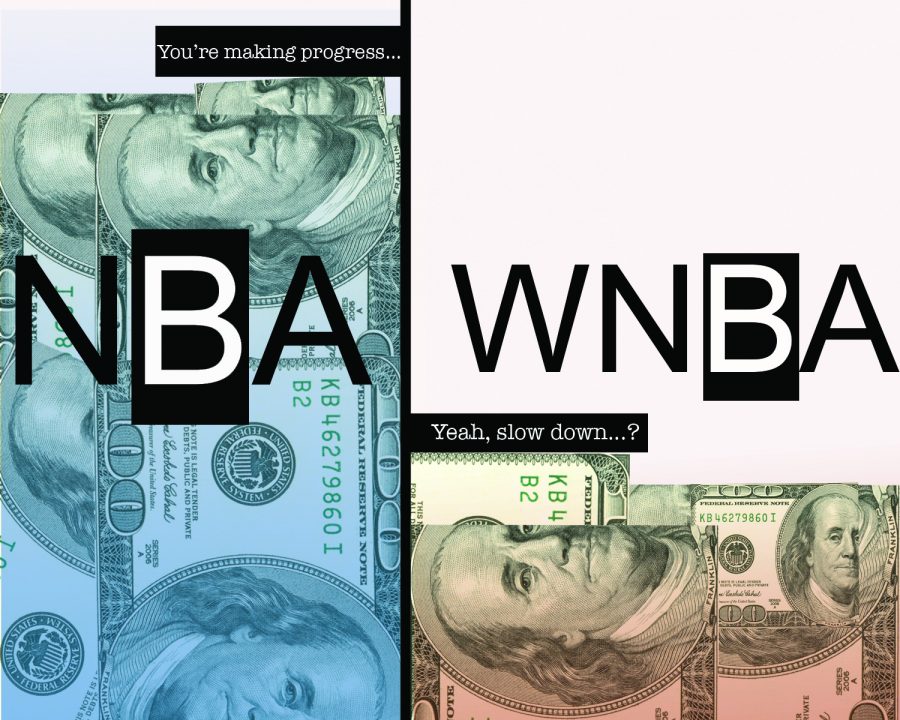Girl power: WNBA on the rise despite inequalities
September 22, 2014
The 2014 WNBA finals have concluded and the TV ratings are up all across the board.
After three games, the 2014 WNBA finals averaged 659,000 viewers per game across all three networks it broadcasts on—ABC, ESPN and ESPN2—up 91 percent from last season’s finals, which averaged 345,000 per game, said WNBA Spokeswoman Dina Skokos, in an emailed statement. Ashley O’Connor, senior manager of programming and acquisitions at ESPN, said the WNBA’s blend of new and experienced players has created an increased appeal for the WNBA and its viewers.
“It’s a really exciting time for the WNBA,” O’Connor said. “The influx of younger players still teaming with some of the best players from a few years ago has made the WNBA a stronger property.”
Since adding superstars Elena Delle Donne, Brittney Griner and Skylar Diggins—dubbed by the league as the “three to see”—in its historic 2013 draft, the first to ever be televised on primetime, the WNBA has continued to show growth in merchandise sales, viewership and attendance, according to ESPN.
Alison Moran, women’s sports director at SRN Broadcasting, said the talent these three women have is something seldom seen in any sport.
“How often do you see a six [foot] eight woman who can dunk?” Moran said. “How many times do you find someone like Elena Delle Donne, who’s really the whole package? Or Skylar Diggins, who is just so explosive.”
While the WNBA continues to find its footing in the sports world, staggering inequalities remain between the league and its older counterpart, the NBA.
According to an analysis by Buzzfeed Sports, there are approximately 52 NBA players who individually bring in a higher salary season than all WNBA players combined. Los Angeles Lakers guard Kobe Bryant is one such player. Bryant’s $30 million salary is nearly three times the $10.3 million the entire WNBA earns.
Though the WNBA does not disclose the individual salary of each player, $107,000 is the maximum amount a player can make, and $37,950 is the minimum, according to the analysis. Low salaries have led some of the WNBA’s players, such as Griner, to play overseas in the offseason, where they can make nearly six times the WNBA’s maximum salary, according to espnW.
Griner made at least $600,000 for a four-month season playing in China for the WCBA’s Zhejiang Golden Bulls, according to an espnW report. WNBA President Laurel Richie said the new eight-year collective bargaining agreement—negotiated before the start of the 2014 season—should help counter the lure of a bigger salary and stop most players from going overseas.
“Within [the new agreement] there are provisions for regular increases in the salary cap,” Richie said. “Also for the first time, we created a time-off bonus designed to create an incentive for some players to limit their play overseas during the WNBA offseason.”
The TV contracts for each league also reveal financial disparities between the two. The WNBA’s contract is worth $12 million per season and allows up to 30 live games—out of a possible 204— including coverage of the playoffs, draft and All-Star Game, according to an espnW article detailing the contract.
The NBA’s TV deal is currently worth just less than $1 billion per season, but with the current renegotiation the NBA is in for its television rights, that could soon be chump change, according to Sports Business Daily.
O’Connor declined to comment on the financial details of either league’s TV deal.
However, Moran said the salary and TV numbers may be a bit overblown given how new the WNBA still is.
“This league is only 17 years old,” Moran said. “It took [the NBA] decades to get to [the level] where they are now.”
Moran also said WNBA players will see pay increases for all their hard work as the WNBA continues to establish itself and profits for the league continue to increase.
“For what the WNBA players do, they deserve to make what NBA players do,” Moran said. “What the [WNBA] is paying now is about as fair as it’s going to get. When the league is celebrating its 25th birthday, you’re going to see better salaries.”
In the coming years, the WNBA could see more than just salaries increased, though. As TV viewership, merchandise and ticket sales continue to increase, the added revenue could mean new teams being introduced to the league.
The WNBA currently has just 12 teams, fewer than half of the 30 teams the NBA has. Richie said future expansion for the WNBA is almost a certainty, even if it is not in the immediate future.
“Expansion is absolutely on the horizon,” Richie said. “I wouldn’t say the immediate horizon, but we have a handful of potential owners and groups who have come forward, expressing interest in bringing a WNBA team to their city or bringing it back to cities in which we have had teams in the past.”








